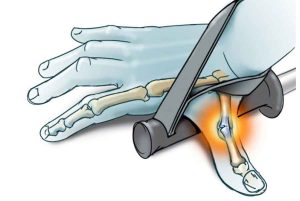12 Jul Skier’s Thumb
Now hand physio is a specialty on it’s own, but I’ll do my best to explain skier’s thumb and how to manage it, PLUS I’ll show you a simple tip to help prevent it!
What is it?: Technically, it is called a sprain of the ulnar collateral ligament of the first MCP joint, which is the ligament on the inner side at the base of your thumb.
The cause: It is commonly referred to as skier’s thumb because a typical cause is from a forced abduction and hyperextension of the joint, which can happen if you fall while holding onto a ski pole.

IMAGE: https://gearjunkie.com/skiers-thumb-injury-fall-skiing
Signs & symptoms: It will usually start with a sudden onset of pain in the area and you may hear a popping sound. It’s then usually tender to touch and becomes quite swollen. A common sign is also that your pinching grip between your thumb and first finger becomes weak.
Confirm diagnosis: You should usually have an x-ray first to negate any fractures, then a physio is able to perform a test to assess the stability of the ligament. They do this by gently stressing the joint to see how much movement it allows. Typically, if there is movement of 10-20 degrees more than the non-injured side it is diagnosed as a partial tear. If it is more than this (and there is no clear end feeling of the movement) is likely to be a complete tear.
How to treat it: A partial tear should be treated with immobilisation in a splint with the MCP joint in slight flexion for 6 weeks. Further protective splinting is required for during return to sport under the guidance of a physio and may be required for up to 12 months. A complete tear typically requires surgical repair. Following surgery it is often placed in a cast for 4-6 weeks, then requires protective splinting during sport for a further 3 months. In both instances, a hand physio will guide you through appropriate exercises to regain your finger and hand range of movement and strength.
It is also important to mention that these types of injuries are often neglected by people with the expectation they will improve on their own which means by the time you actually seek help it may be too late for effective treatment. So it is important to see a physio ASAP so that long term deformity and loss of function can be avoided.
Also, as I mentioned at the start, hand physio is a real specialty so a physio who does not see hand injuries regularly should refer you to someone who does (or at least seek their advice), so don’t be shy when asking your physio if they are the right person to see, as a good physio won’t be offended. To find a physio in your area of Australia or New Zealand click here.
Prevention: Prevention wise, when skiing if you reach your hands from underneath the leash and then grip over the top of it, then as you fall you can let go of the pole and let it drop away from your hands. Whereas, if you come in through the top, you are more likely to land with it in the position that causes skier’s thumb (watch the video for a demonstration).
Remember to sign up to my mailing list or follow me on Facebook or Instagram for regular physio tips.


